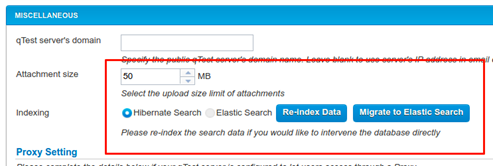Global Configurations OnPremise
This article provides details on the OnPremise version of Global Configurations, that are available to a qTest Site Administrator.
The Configurations page allows you to set global time settings for your qTest instance, as well as generate Insights dashboard tokens to share dashboards with a URL.
How to Get Here
Navigate to Site Administration, and select the Configurations tab.
System Information
This section displays the following information for your specific system and environment:
-
Server Base URL
-
Server ID
-
qTest Version
-
Operating System
Email Server Configuration
qTest onPremise requires an email server to send outgoing notification messages to the site users. This section allows you to establish and maintain your email notifications.

qTest Explorer | Sessions
Enter the URL associated with your qTest Explorer/Sessions application. Test the Connection and Save.
qTest Scenario
Enter the URL associated with your qTest Scenario application and the API Key. Test the Connection and Save.
qTest Parameters
Enter the URL associated with your qTest Parameters application. Test the Connection and Save.
qTest Pulse
Enter the URL associated with your qTest Explorer/Sessions application. Test the Connection and Save.
qTest Launch
Enter the URL associated with your qTest Launch application. Test the Connection and Save.
Generate an Insights Dashboard Token
-
Locate the Insights section of the window.
-
Select the Generate button to create a new, secure Dashboard Token. Note: At any time you can generate a new, secure Dashboard Token that will replace the previously created Dashboard Token. The new token will be used by qTest to generate a shareable URL.
Green circle icon = Dashboard Token is active
Gray circle icon = Dashboard Token is expired
-
The Expiration Date default is 90 days from token generation. However, you can change it to another expiration date using the drop-down.
-
Select Save. Note: A Dashboard URL generated before the Insights 1.15.6 release, will continue to work until the dashboards expiration date.

Miscellaneous
qTest Server's Domain
Displays your qTest Server domain.
Attachment Size
This section allows you to edit the attachment size used for uploading attachments to Requirements, Test Cases, etc.
Data Indexing
OnPremise version 9.5.3 includes ElasticSearch as a prerequisite, allowing for greater search capabilities within Manager.
| Fresh Installs for 9.5.3 | ElasticSearch will be automatically enabled. |
| Upgrades to 9.5.3 | By default, the previously used Hibernate Search will be selected. You must migrate to ElasticSearch. |
Additionally, ElasticSearch must be enabled to use Tricentis Analytics reporting which is compatible with Manager 9.6.1.
These Data Indexing administration functions allow you to choose when you want to migrate your data from Hibernate to Elasticsearch, as the re-indexing may take some time to complete.
Migrate to ElasticSearch
-
Select the Migrate to ElasticSearch button. (This may take some time to complete and may affect other users. So please use discretion when performing this step.)
-
Once the migration is complete, the Migrate to ElasticSearch button disappears.
-
Reload the page, and the ElasticSearch button enables.
-
Select the ElasticSearch radio button and Save your changes to begin using your ElasticSearch database. Note: It is HIGHLY recommended to select the Re-index Data button after switching to ElasticSearch. This ensures that any new data that was created, after performing the migration process, is indexed to the ElasticSearch server.

Re-index Data
Re-indexing your data could be used for the following scenario and others like it.
Example: A new test case is created, but it is not appearing in your search. Select the Re-index Data button as a manual step before contacting Support.

Proxy Setting
If your qTest server is configured to let users access through a proxy, you will need to supply the following information.
-
Proxy URL
-
Proxy username
-
Proxy password
-
Secured Proxy URL
-
Secured Proxy username
-
Secured Proxy password
Internationalization
